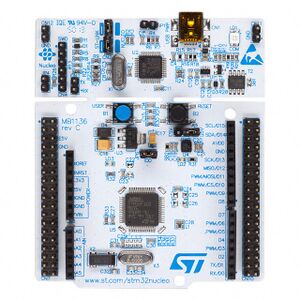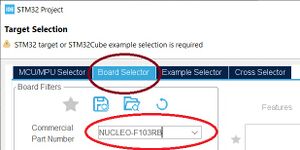Getting Started with STM32
Although this getting started class will work well for many of the STM32 processors and boards, we will focus on the NUCLEO-F103RB board with its STM32-F103RB processor.
Class Description
64-Pin NUCLEO Board

* Green LED, LD2, connected to PA5, illuminates when driven high * Blue PushButton, B1, connects to PC13, 4.7K external pullup, signal connects to ground when pressed * 32,768Hz crystal oscillator, LSE, used for Real Time Clock (RTC) * 8MHz HSE, is provided by the 8MHz crystal oscillator from the attached ST-Link, into PD0 * UART2 connects the target processor to the ST-Link, providing a USB COM port connection on the host computer. Uses PA2 for TX, and PA3 for RX. * ST-Link connects to TCK (PA14), TMS (PA13) Board: https://www.st.com/en/evaluation-tools/nucleo-f103rb.html Manual: https://www.st.com/resource/en/user_manual/um1724-stm32-nucleo64-boards-mb1136-stmicroelectronics.pdf Schematic: https://www.st.com/resource/en/schematic_pack/nucleo_64pins_sch.zip
Processor: STM32F103RBT6
* 128KB Flash, organized as 128 - 1K sectors * 20KB SRAM * 72MHz clock * Single-cycle multiplication and hardware division * 2.0 to 3.6 V application supply and I/Os * Within this part series, this is considered a "Medium-density device", and as such, has the following peripherals: * 3 USARTs * 3 16-bit timers * 2 SPIs, 2 I2Cs, USB, CAN, 1 PWM Timer, 2 ADCs Notes: "Low-density device" has fewer peripherals. "High-density device" has more peripherals.
Software - Development Tools - IDE
I recommend creating an STMicro account to make multiple downloads easier. Download the following tool(s) from STMicro: https://www.st.com/en/development-tools/stm32cubeide.html (Required) Optional tools (not necessary for the class) https://www.st.com/en/development-tools/stm32-software-development-tools.html STM32CubeProg - Programming tool to write/read firmware to/from the target processor STSW-Link007 - ST-Link Firmware Upgrade tool STSW-Link009 - Windows Device Drivers for ST-Link adapters
Installing STM32CubeIDE
* Allow the software to install at C:/ST/STM32CubeIDE_X.XX.X * When asked where to store project files, I recommend creating a path off of C:/Users/YourName/Documents Something like: C:/Users/YourName/Documents/STM32_Projects This makes your projects easy to find and backup.
Create a New STM32CubeIDE Project - Blinky
1 Click "File" -> "New" -> "STM32 Project", then select the "Board Selector" tab
2 In the Commercial Part Number box, type "NUCLEO-F103RB", select the board, and then click "Next>" at the bottom
3 Since I have several STM32 boards, I like to have the board name in the name of the project
I used: "NUCLEO-F103RB_Blinky" as the project name
4 Select "C++" (This allows both C and C++), Executable, STM32Cube Proect Type, Finish
5 Initialize all peripherals with their default Mode ? - Yes
6 Device Configuration Tool editor is associated with Device Configuration Tool perspective.
Do you want to open this perspective now? (Select Yes to see what's configured)
7 Under "Project Manager Tab", Linker Settings, I set both Minimum Heap Size and Minimum Stack Size to 0x800 (2K bytes each)
8 On the left, Project Explorer window, Open Core->Src->main.c
Note: If you examine the source code, you will see that the following functions get called:
* HAL_Init()
* SystemClockConfig()
* MX_GPIO_Init()
Then, the code enters an empty while loop. Using the JTAG/SWD debugger, we can build, run, and debug the code,
but it will be rather boring...
9 Find the infinite loop inside the main() function, and add the following two bold lines of code:
/* Infinite loop */
/* USER CODE BEGIN WHILE */
while (1)
{
HAL_GPIO_TogglePin(LD2_GPIO_Port,LD2_Pin);
HAL_Delay(500);
/* USER CODE END WHILE */
/* USER CODE BEGIN 3 */
}
NOTE:
Be sure to always place your code between the USER CODE BEGIN and USER CODE END comments
This will protect your code from being removed should you make changes using the STM32CubeMX again.
10 Click the Hammer Icon for "Build"
The program will be compiled, linked, and located to run on your NUCLEO-F103RB
11 Click the Right Pointing Green Arrow Icon for "Run"
The program will be downloaded to the device and begin execution.
You should see LED2 blinking at this point.
Create a New STM32CubeIDE Project - Hello-World
Follow the example above to create a new project. The printf() function is commonly used for "C" programming to output formatted text to a terminal. This allows easy debugging in that variables, intermediate values, entering/leaving functions can be monitored and status displayed with the printf() stdio library function. The STM32 development environment provides an stdio printf() library function, but some "connecting glue" is required to provide the desired output. The printf() function calls _write() to perform an output function. See the _write() function in syscalls.c. This function was given the (weak) attribute, allowing the function to be over-written (without causing a warning or error message.) This default _write() function calls __io_putchar() to output one character at a time. Redefining either function to write characters to a serial port will produce a functioning printf(). Important note when using printf(): The standard stdio library used to implement the printf() function will buffer the stdout stream data before it is sent to the lower level output function. This results in non-full lines not printing until a line feed character is sent. To avoid this problem, add the following line to request the stdout stream to be unbuffered: setvbuf(stdout, NULL, _IONBF, 0);
Add putchar() and getchar() Functions:
Add the following serial output and serial input code to main.c, in the specified sections:
/* Private user code ---------------------------------------------------------*/
/* USER CODE BEGIN 0 */
#define HAL_SMALL_WAIT 40
// Define serial input and output functions using UART2
int __io_putchar(int ch)
{
HAL_UART_Transmit(&huart2, (uint8_t *)&ch, 1, HAL_SMALL_WAIT);
return 1;
}
// Read a character from the UART with small timeout
// This function works well if called within a 50ms or shorter loop, but may lose characters if
// data is received with any real speed.
// Use DMA for receive data if trying to perform higher speed communication (anything faster than typing).
// If HAL_UART_Receive() returns error, return EOF (-1), else return the character read
int __io_getchar(void)
{
uint8_t byte;
HAL_StatusTypeDef hal_status = HAL_UART_Receive(&huart2, &byte, sizeof(byte), HAL_SMALL_WAIT);
if(HAL_OK == hal_status)
{
return byte;
}
else
return EOF;
}
/* USER CODE END 0 */
Add stdio.h include:
/* Private includes ----------------------------------------------------------*/ /* USER CODE BEGIN Includes */ #include <stdio.h> // printf() /* USER CODE END Includes */
Add printf() into your code:
/* USER CODE BEGIN WHILE */
while (1)
{
HAL_GPIO_TogglePin(LD2_GPIO_Port, LD2_Pin);
printf("Hello World\n");
HAL_Delay(500);
/* USER CODE END WHILE */
/* USER CODE BEGIN 3 */
} // while(1)
/* USER CODE END 3 */
} // main()
At this point, you should be able to build, download, and run, with a flashing LED
and "Hello World" repeatedly displayed in a terminal window.
Create a New STM32CubeIDE Project - Command_Line
On this website, Command Line, has it's own web page. Feel free to read the page, OR, maybe you just want to watch it work... Either way, scroll down to the Source Code section and get "command_line.c" and "command_line.h" onto your host computer. Command_Line_Interface Then, copy the files into the <project>/Core/Src folder. Do this by selecting the file(s), right click <copy> and then right clicking on the Src folder and using the <paste> function. Once you have the files in your project, add the function calls as documented in the following two sections.
At this point, you should be able to build, download, and run a command line interface using
a serial terminal program like TeraTerm or Putty.
Using LittleFS
On this website, LittleFS Flash File System, has it's own web page. Feel free to read the page, OR, maybe you just want to watch it work... Either way, scroll down to the My Source Code section and get "littlefs_interface.c" and "littlefs_interface.h" onto your host computer. STM32 - LittleFS Flash File System Interfacing Then, copy the files into the <project>/Core/Src folder. Do this by selecting the file(s), right click <copy> and then right clicking on the Src folder and using the <paste> function. Once you have the files in your project, modify the original code as follows to use the new functionality: 1a) In command_line.c, add #include "littlefs_interface.h" with the other #includes. 1b) Within cmd_table[], add LITTLEFS_COMMANDS, /* set of commands from littlefs_interface.h */ at the bottom of the table, but above the {NULL,NULL,0,NULL}, /* end of table */ This includes a whole set of file commands into the command table. 2) The source code for LittleFS needs to be added into the project Download the LittleFS source code from https://github.com/littlefs-project/littlefs Unzip the folder into the project such that the directory structure looks something like: Core Inc LittleFS Src There are plenty of files within this package, but only the core source / header files are needed: lfs_util.c <- this file provides a software CRC implementation for LittleFS lfs_util.h lfs.c <- this file provides all the essential functionality of LittleFS lfs.h
At this point, you should be able to build, download, and run a command line interface using
with a new set of file functions added, allowing files to be created, renamed, copied, and displayed.
See: "STM32-Using DMA for Serial Receive" to improve serial reception and to add X-Modem commands.
Interface a rotary encoder
The STM32 family provides timers to support a rotary encoder, reading "CH A", and "CH B" signals, debouncing the switches, creating a counter that counts up when the encoder rotates one way, and counts down when the encoder rotates the other way.
The vertical dashed line in the diagram above represents the current position of the encoder. As the dash line is "moved" along the 'CH A'/'CH B' waveforms, the corresponding high/low signals will be sent to the STM32.
Wiring Diagram
Encoder Signal Wire Color NUCLEO Pin STM32 Signal
CLK Orange CN7-28 PA0 (TIM2_CH1)
DT Brown CN7-30 PA1 (TIM2_CH2)
SW Yellow CN7-38 PC0
+ Red CN7-16 3V3
GND Black CN7-20 GND

KY-040 Rotary Encoder Module
Example STM32 Project using NUCLEO-F103RB
https://github.com/JimMerkle/NUCLEO-F103RB_Rotary_Encoder
Miscellaneous
Using the JTAG (SWD) Debugger
This assumes you have a project that builds and maybe runs to some degree, but something is broken...
1) Instead of the "Run" button, click on the "Run->Debug As..." 2) Using the JTAD (SWD) debugger, the application will launch, and stop at a breakpoint set at HAL_Init(), allowing you to begin debugging from there. 3) Set a breakpoint where you want to begin debugging, example - at the MX_GPIO_Init() call. 4) Click the "Resume" button, allowing the processor to run until it hits the breakpoint 5) You can "Step Into" (F5), or "Step Over" (F6) lines of code. You can also step out of a function using "Step Return" (F7) STM32Cube Monitor: https://www.st.com/en/development-tools/stm32cubemonitor.html
Where is everything?
Once an STM32 processor or development board is selected, STM32CubeIDE downloads and installs a firmware package for the device selected. I found the install location for the “F1” firmware here: C:\Users\JimMerkle\STM32Cube\Repository\STM32Cube_FW_F1_V1.8.4 Within this folder are header files, HAL source code, middleware, driver code, example code, and documentation for the firmware package. Each project includes a copy of the header files needed for a build. (Just drill down inside the project's Driver folder.) Example: C:\Users\JimMerkle\Documents\STM32_Projects\NUCLEO-F103RB_Blinky\Drivers\STM32F1xx_HAL_Driver\Inc\stm32f1xx_hal_gpio.h
Additional Resources:
Shawn Hymel - How to use printf() on stm32 Digikey Forum: Easily Use Printf On STM32 NUCLEO-F103RB Documentation - Mbed

